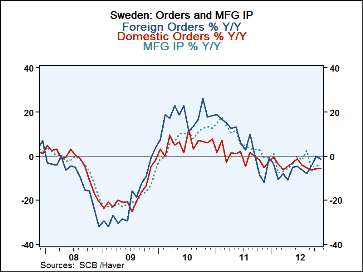 Global| Jan 10 2013
Global| Jan 10 2013Sweden Locks Into Slowdown
Summary
In the chart there is a perception of Sweden possibly being led toward recovery by foreign orders which are not as weak as for domestic orders or as weak as industrial production. But on the shorter intra-year view, the sequential [...]
 In the chart there is a perception of Sweden possibly being led toward recovery by foreign orders which are not as weak as for domestic orders or as weak as industrial production. But on the shorter intra-year view, the sequential growth rates show that foreign order trends from one year and in are as weak as output trends and domestic order trends.
In the chart there is a perception of Sweden possibly being led toward recovery by foreign orders which are not as weak as for domestic orders or as weak as industrial production. But on the shorter intra-year view, the sequential growth rates show that foreign order trends from one year and in are as weak as output trends and domestic order trends.
Over three and six months foreign order trends are slightly weaker than their domestic counterparts.
For industrial output, weakness in intermediate goods is holding back the degree of the overall decline in output with a 12% annual rate over three months. Drops in investment goods output have accelerated and are particularly sharp (-22% annual rate) over the most recent three-months. Consumer goods output is falling fast as well with negative growth of 27% annualized for durable goods and -26% for nondurable goods.
Manufacturing output in Sweden is some 17% below its cycle peak level. Motor vehicle output is one of the big reasons as it is exceptionally weak at only 52% of its pre-recession peak. Investment goods output is 25% below its past peak. Consumer goods are divided with consumer nondurable goods output only 11% below its past peak and durable goods output about 38% below its past peak.
Orders are roughly 26% below their past peak overall as well as for foreign and domestic orders.
On balance Sweden is suffering from the slowdown ills that are sweeping the rest of Europe and it is not showing any resiliency. The EU indices showed that Sweden had fallen sharply in November as its overall sentiment reading crashed to 93.2 in November from 97.2 in October. But in December Sweden made a partial recovery to 94.8 from 93.2. Still, that is not much of a softening on this sharp drop that has been experienced in November and that is so evident in the orders and output reports chronicled above.
| Sweden: IP and Order Trends | ||||||||
|---|---|---|---|---|---|---|---|---|
| Month-to-Month | Saar | % of | ||||||
| IP | Nov-12 | Oct-12 | Sep-12 | Aug-12 | 3-mo | 6-mo | 12-Mo | Cycle Max |
| Excl Construction | -1.3% | 0.6% | -4.2% | -0.1% | -17.9% | -9.0% | -4.0% | 83.8% |
| MFG | -1.5% | 0.5% | -4.3% | 0.4% | -19.4% | -10.2% | -4.5% | 82.7% |
| Motor Vehicles | -1.4% | -5.2% | -7.7% | 12.2% | -44.8% | -30.3% | -14.5% | 52.7% |
| Intermediate | 0.3% | -1.3% | -2.3% | -1.5% | -12.5% | -6.5% | -5.3% | 81.0% |
| Investment | -1.4% | 0.8% | -5.4% | 0.2% | -21.7% | -9.7% | -7.0% | 75.0% |
| Consumer Dur | -1.0% | 0.7% | -7.3% | -4.7% | -27.0% | -13.9% | -6.4% | 61.8% |
| Consumer N-Dur | -4.9% | 4.7% | -7.0% | 3.8% | -26.2% | -21.7% | 2.2% | 89.2% |
| Orders | Nov-12 | Oct-12 | Sep-12 | Aug-12 | 3-mo | 6-mo | 12-Mo | Cycle Max |
| Total | -5.3% | 0.2% | 1.1% | -2.7% | -15.2% | -15.3% | -3.2% | 74.24% |
| Domestic | -1.8% | -1.8% | 0.7% | -1.7% | -11.1% | -13.7% | -5.5% | 73.64% |
| Foreign | -7.5% | 1.8% | 1.3% | -3.2% | -17.5% | -16.2% | -1.4% | 74.13% |
Robert Brusca
AuthorMore in Author Profile »Robert A. Brusca is Chief Economist of Fact and Opinion Economics, a consulting firm he founded in Manhattan. He has been an economist on Wall Street for over 25 years. He has visited central banking and large institutional clients in over 30 countries in his career as an economist. Mr. Brusca was a Divisional Research Chief at the Federal Reserve Bank of NY (Chief of the International Financial markets Division), a Fed Watcher at Irving Trust and Chief Economist at Nikko Securities International. He is widely quoted and appears in various media. Mr. Brusca holds an MA and Ph.D. in economics from Michigan State University and a BA in Economics from the University of Michigan. His research pursues his strong interests in non aligned policy economics as well as international economics. FAO Economics’ research targets investors to assist them in making better investment decisions in stocks, bonds and in a variety of international assets. The company does not manage money and has no conflicts in giving economic advice.






